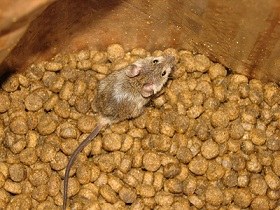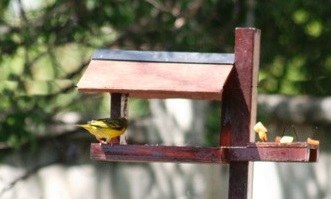Here are 5 simple POISON FREE steps that you can implement around the house or office which will reduce rodent infestations this winter.
| 1 | 2 | 3 | ||
 |
 |
 |
||
| Cut back tree branches that touch, or are within a metre of the roof. Rats use these branches as runways between the house and the garden. By removing branches that touch the roof, you are effectively reducing accessibility to rats and preventing possible rodent infestations within the house. | Dog food is a great source of nutrition for rats and dog pellets are commonly found in rodent nests. According to most dog nutritionists, your canine pet should ideally be fed in the mornings and in the evenings and free feeding is not recommended. Leaving dog pellets out at night is really just ringing a dinner bell for your nocturnal rodent family. Either placing an upside down container over your dog bowl or removing the dog bowl altogether will reduce the free feeding of rodents – something we at EcoSolutions definitely don’t recommend. | Cracks in walls and the gap where roofs and walls meet are easy places for rats to gain access to your home. It should be remembered that even though there is no food in your roof, rats require a dark warm environment in which to raise their young. They do need to leave the roof on a nightly basis to search for food and by making your roof inaccessible you immediately reduce the potential for a symbiotic rodent/homeowner relationship. The filling of gaps and cracks with copper steel wool or even aluminium foil (rats don’t like chewing foil – who does?) effectively excluding rats from sharing your home. | ||
| 4 | 5 | Bonus Tip | ||
 |
 |
|||
| Bird feeders – We all love feeding our garden birds but when we look out of our window in the early morning and see a dirty great rat sharing in our avi-faurnal offerings we feel a little offended. Garden bird feeding during the day is often feeding our rats during the night. There are 2 options here – the first is to remove bird feeders and bird food at dusk. This will reduce the free access to a valuable rodent food option and as such, help to reduce rodent populations. The second option is to provide bird food to your birds on a free standing rodent proof bird feeders. This type of feeder stands away from trees and has a slip pad at its base which prevents rodents from climbing up it. It can be moved around the garden and is also designed to prevent pigeons from making pigs of themselves at the expense of all their more desirable cousins. | Compost heaps and ivy are all great for rats. Compost heaps provide both food and harbourage, while ivy is a wonderful secluded highway through which your rodent families commute. This might sound a little Capetonian to our Highveld members but it can be checked out on the internet – and not just on Cape Town sites – MINT. Plant mint. Although not as sensitive as dogs, rat have a highly sensitive olfactory system and they find the strong smell of mint very unpleasant. It’s simple - give it a try. | Mother-in-laws. A famous person once said “when my mother-in-law visits, the rats throw themselves on the traps” enough said. |
EcoSolutions consults to both private residences and businesses on poison free pest control and exclusions. We can help you turn your home or work place into a rodent “no go” zone. If you would like to know more, drop us a mail here or visit our online store to request a consultation.
Finally – DO NOT USE POISON! Not only is it environmentally irresponsible, it also does not work. If you haven’t addressed the points above, no matter how much poison you use, you will still have rats!
BE POISON FREE